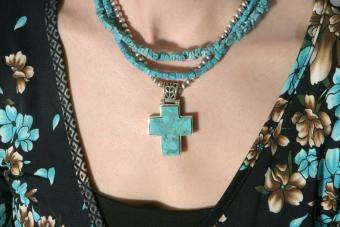
Roman glass jewelry has a distinct beauty that is immediately recognizable over other glass jewelry. In fact, there are companies that specialize in making jewelry from ancient Roman glass objects.
Ancient History: Roman Glass Production
The first Roman glass was used to create vessels for water and olive oil. As the popularity of glass grew, craftsmen found other uses for this material. Vases, goblets, bowls, perfume pots, and pitchers followed. Additional uses for glass included colorful mosaic tiles used in homes and various artifacts. There were even a few glass windows that only the very wealthy could afford.
Glass Blowing Technique Changes Ancient Industry
During the first century AD, the art of glass blowing created a major industry change, and colorless glass was all the rage. The glass industry grew with many factories located in modern-day Israel and other regions throughout the empire. By the end of the century, the demand was so vast and the industry had grown so considerably that the cost of glass was affordable to the average Roman. Colored glass still remained a favorite, especially mosaic patterned glassware. Later, colorful striped glassware was produced and became highly prized. Glass was also used in making jewelry.
Glass Colors
Ancient Roman glass came in an array of colors such as cobalt blue, emerald green, aqua, Persian blue, dark blue, seafoam green, and other hues. Patterns and designs were created by fusing and melting different colored glass rods together.
Floral and Spiral Patterns
Flora, also known as millefiori, and spiral patterns were created through a heating process where colors were infused in clear or contrasting colored glass. Glass makers took different colored rods of glass and fused them together into one piece. These rods were then cut in a cross-section style. Once sliced, the rods were like round discs that were fused together again and then melted. This process created very unique and complex flower patterns and was often used to form glass plates. For spiraling patterns, the glass blower would select two different colored rods and then fuse them together so they could be wrapped around a glass rod for a truly colorful spiraling effect.
Marbled and Other Stone Designs
Dappled and marbled designs were created to imitate natural marble and other stones. This type of glass was a popular choice for bowls and other household items.
Lace Patterns
Lace patterns were designed by twisting strips of colored glass with threads of contrasting colors. These were then fused together and the result was a lace-like pattern.
Roman glasswork also was used in combination with gold and silver to create jewelry.
Archeological Excavations of Roman Glass
The Roman glass used to make jewelry comes from various archeological excavations throughout the ancient cities of the Roman Empire. Pieces of various types and colors of Roman glass have been unearthed in Africa, the Middle East, and as far east as a tomb in China. Much of the Roman glass on the market today comes from Israel, where Roman factories once churned out glass products. Buried beneath sand for over 2,000 years, the elements have left heated trails of mineral deposits in the glass. This natural effect gives Roman glass a new life, transforming it with specks of color that sparkle in sunlight.
Types of Roman Glass Jewelry
The Romans were great builders of cities and commerce. They left behind monuments, drawings, sculptures, and many other artifacts throughout the vast regions that were once part of the Roman Empire. There are a wide variety of artifacts that are easily accessible for jewelers to use for inspiration in designing each unique piece of jewelry. No two pieces are alike, since each piece of glass is different.
Ancient Artifacts Recycled
Excavated broken shards of glass and other partials pieces are being recycled into great jewelry designs by some very talented artisans. Jewelers use this special glass to create rings, cufflinks, necklaces, brooches, bracelets, cuff bracelets, earrings, and pendants. There are specialty websites that feature Roman glass jewelry, including:
Own a Piece of History
Imagine wearing a piece of glass jewelry that's over 2,000 years old and was once part of a vase, goblet, or bowl found in an ancient Roman household. You might wonder about the people who created the glass in one of the Roman factories or imagine the person who purchased it at a local market. It's one thing to visit a museum and see artifacts behind glass cases, but it's quite another to have the rare opportunity to own a piece of history that you can actually wear as a fashion statement.







